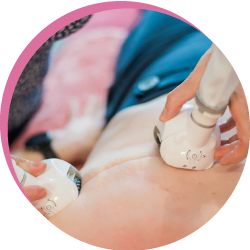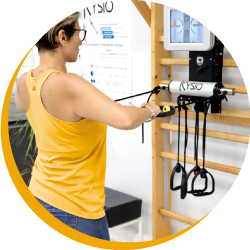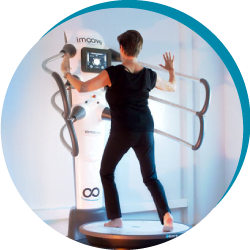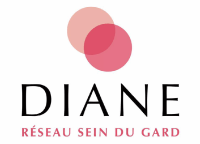Multi Micro Alveolar Stimulation
Solutions for senology

Skin and connective tissue care
Gesture control with biofeedback

Your espalier becomes intelligent and interactive
3D Elispheric Movement

Rehabilitation & neuromotor performance
Introduction to senology
With almost 59 000 new cases detected each year in France, breast cancer is the most common cancer among women. Although it is still the leading cause of cancer-related death among women, medical advances, early screening and information campaigns such as Pink October have all helped to significantly improve the survival rate of patients.
But once recovery has begun, it’s time for physical and psychological reconstruction, which is essential if we are to overcome this ordeal and gradually return to a normal life.
The importance of physiotherapy after breast cancer
A diagnosis of breast cancer justifies the implementation of a strategy that combines, in whole or in part, the following therapeutic methods: chemotherapy (CT), surgery, radiotherapy (RT), targeted therapies and hormone therapy (HT)… Although they cause numerous side-effects, most women will be cured (85-90% at 5 years). To ensure that quality of life is associated with this recovery, physiotherapy offers a range of techniques to help with the total reconstruction of the patient’s body.
Partial or total mastectomy, sentinel lymph node biopsy, axillary dissection, immediate reconstruction, delayed reconstruction or without reconstruction, treatments are adapted to the characteristics of the cancer (in situ, infiltrating, hormone receptor, HER2 or triple negative, genetic, metastatic, etc.). In all cases, from the mildest to the most virulent, the ultimate aim of the rehabilitation carried out by the physiotherapist is to enable the patient to regain body and tissue movement, and to engage in appropriate physical activity, which, thanks to numerous studies, has been shown to help prevent recurrence.
While manual “hands-on” techniques and “hands-off” exercises are essential, to achieve the best possible results, the rehabilitator must be assisted by instrumental techniques that have proved their worth in transforming connective tissue: scars, oedema and lymphoedema, fibrosis, tissue transformations with pain, with or without inflammation.

Completely natural and painless, icoone® is the ideal technology for preventing and acting against these side effects. From the very first session, the results are visible, palpable and felt on all types of tissue, even the most fragile.

Using the Kysio® unit, which records and analyses movement, the physiotherapist helps the patient to fully recover joint amplitude, strengthen upper and lower limb muscles and improve posture.

With the imoove® destabilisation platform, the physiotherapist supports the patient in a phase of resumption of physical activity, enabling mobilisation, proprioception, muscle strengthening and overall postural rehabilitation.
Complementary technologies to restore body movement !
icoone® supports Réseau Diane every year !
Web-presentation: a simple, practical way to discover all our solutions.
Discover our technologies and their applications from the comfort of your own home in just 15 minutes.
Replay of the conference
Use of icoone in senology
icoone Talks
« The effectiveness of icoone® micro-stimulation in breast cancer rehabilitation »
by Jocelyne Rolland | Senologist physiotherapist.
Senology training
Breast science | Breast cancer
Allcare Academy
« Reconstructing body and tissue movements to rebuild an injured woman » : A specific training course for physiotherapists has been created and is given by Jocelyne ROLLAND in our Allcare Academy training centre.
Theory is supplemented by practical sessions. In this way, physiotherapists can develop their clinical reasoning and the resulting overall support for the patient.







